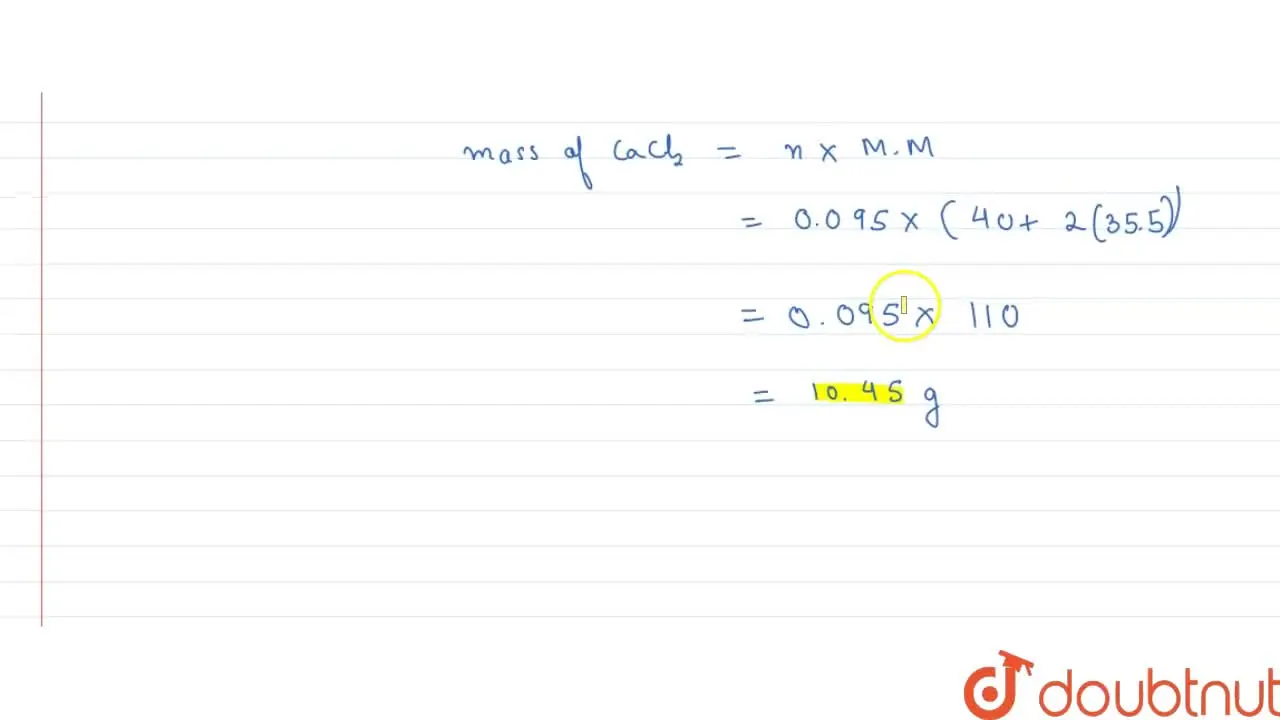Calcium carbonate reacts with aqueous HCl to give CaCl2 and CO2 according to the reaction given below
CaCO3(s)+2HCl(aq)→CaCl2(aq)+CO2(g)+H2O(l)
What mass of CaCl2 will be formed when 250mL of 0.76 M HCl reacts with 1000 g of CaCO3? Name the limiting reagent. Calculate the number of moles of CaCl2 formed in the reaction.
Molar mass of CaCO3=40+12+3×16=100gmol−1
Moles of CaCO3 in 1000g,nCaCO3=mass(g)molar mass
nCaCO3=1000g100gmol−1=10 mol
Molarity =moles of solute(HCl)×1000Volume of solution
(It is giv en that moles of HCl in 250mL of 0.76M HCl=nHCl)
0.76=nHCl×1000250
nHCl=0.76×2501000=0.19 mol
CaCO3(s)+2HCl(Aq)→CaCl2(aq)+CO2(g)+H2O(l)
1 mol 2 mol
According to the equation
1 mole of CaCO3 reacts with 2 moles HCl
∴ 10 moles of CaCO3 will reacts with 2 moles HCl
But we have only 0.19 moles HCl, so HCl is limiting reagent and it limits the yield of CaCl2.
Since, 2 moles of HCl produces 1 mole of CaCl2
Molar mass of CaCl2=40+(2×35.5)=111gmol−1
∴0.095mole ofCaCl2=0.095×111=10.54g
Related Playlists
Similar Questions
Calcium carbonate reacts with aqueous HCl to give CaCl2 and CO2 according to the reaction:
CaCO3(s)+2HCl(aq)→CaCl2(aq)+CO2(g)+H2O(l)
What mass of CaCO3 is required to react completely with 25mL of 0.75MHCl?View Solution.Calcium carbonate reacts with aqueous HCl to give CaCl2 and CO2 according to the reaction, CaCO3(s)+2HCl(aq)→CaCl2(aq)+CO2(g)+H2O(l) What mass of CaCO3 is required to react completely with 50mL of 0.5MHCl?
View SolutionCalcium carbonate reacts with aqueous HCI to give CaCI2 and CO2, write the reaction.
View SolutionIn the reaction : 2Al(s)+6HCl(aq)→2Al3+(aq)+6Cl−(aq)+3H2(g)
View SolutionCaCO3 +2HCl→CaCl2 + CO2+ H2O
what will be the amount of CaCl2 when 10 gCaCO3 and
200 mL of 0.75 M HCI is used in the reaction ?View SolutionWhat is the limitation of the reaction given
Zn(s)+2HCl(aq)→ZnCl2(aq)+H2↑⏐View SolutionWhat volume of CO2 at STP will evolve when 1 g of CaCO3 reacts with excess of dill . HCI ?
View SolutionFor the reaction CaCO3(s)⇔CaO(s)+CO2(g)kp is equal to
View SolutionWith the help of the equation CaCO3+2HCl→CaCl2+H2O+CO2, calculate the following :
The mass of CaCl2 formed from 10gCaCO3.View SolutionCalcium carbonate decomposes on heating according to the following equations:
CaCO3(s)⇔CaO(s)+CO2(g)
How many moles of CO2 will be obtained by decomposition of 50g of CaCO3?View Solution


